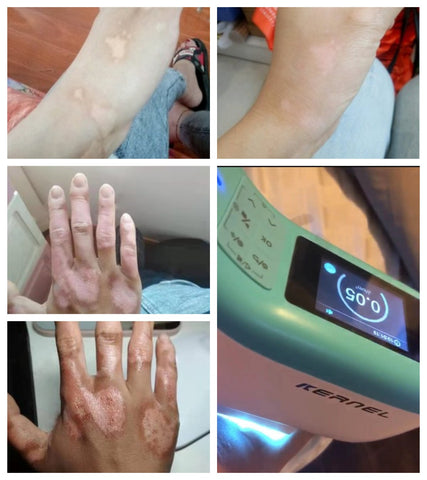No Products in the Cart
The hands bear the crucial responsibility of labor and creating a better life, and they are also our second "face." Whether it is during work or daily life, the hands play an extremely significant role. However, when vitiligo appears on the hands, it brings both annoyance and psychological burden to individuals, and treating this condition can be relatively challenging. So, what are the causes of vitiligo on the hands?

Causes of Vitiligo on the Hands:
Trauma:
Given the essential role hands play in our work and daily activities, they are naturally more susceptible to injuries. If hand injuries are not properly treated, it can damage melanocytes, providing an opportunity for vitiligo to develop.
Excessive Ultraviolet (UV) Exposure:
Exposure to excessive UV radiation can lead to hyperactivity of melanocytes, accelerating their premature death and hindering melanin production, consequently triggering vitiligo. Especially during the hot summer months when hands are exposed to intense UV radiation, the risk of developing vitiligo increases.
Contact with Chemical Substances:
Frequent contact with phenolic compounds and other chemical substances can occur in certain occupations, such as those in the chemical, plastic, rubber, paint, and resin manufacturing industries. Phenolic compounds can selectively damage melanocytes, impeding melanin synthesis and leading to vitiligo on the hands.
Deficiency of Trace Elements:
Poor dietary habits, such as picky eating, selective diets, or excessive consumption of fast food, can result in nutritional imbalances and a deficiency of trace elements needed for melanin synthesis. Insufficient melanin synthesis may lead to the appearance of white patches and the onset of vitiligo.
Psychological Factors:
Modern lifestyles with a faster pace of living and unexpected life events can lead to difficulty in coping and subsequently significant psychological stress. Prolonged negative emotions and excessive mental pressure can disrupt hormonal balance, increase consumption of tyrosine (an amino acid crucial for melanin production), and trigger vitiligo.

Mechanism of Vitiligo Onset:
The direct cause of vitiligo is the immune-mediated destruction of melanocytes in the depigmented areas by T lymphocytes. T lymphocytes require recognition of the target "identity" for immune destruction. In the case of vitiligo, T cells specifically recognize and attack melanocytes. Human hair follicles contain melanocyte stem cells in a primitive state that do not express typical melanocyte markers, allowing them to evade T cell destruction. For vitiligo to recover, these residual primitive melanocytes need to be stimulated by excimer laser to grow into functional mature melanocytes, leading to the repigmentation of the depigmented skin. This is why repigmentation often starts with the appearance of pigment islands around hair follicles, eventually expanding and recovering the affected areas. The different responses to treatment in different body regions are related to the density of melanocytes, the distribution density of hair follicles, the type of hair follicles, and the blood supply to the skin in those areas.There are no hair follicles in the palms and soles of the feet. Therefore, the treatment of vitiligo in these areas is the most difficult.
The hands bear the crucial responsibility of labor and creating a better life, and they are also our second "face." Whether it is during work or daily life, the hands play an extremely significant role. However, when vitiligo appears on the hands, it brings both annoyance and psychological burden to individuals, and treating this condition can be relatively challenging. So, what are the causes of vitiligo on the hands?

Causes of Vitiligo on the Hands:
Trauma:
Given the essential role hands play in our work and daily activities, they are naturally more susceptible to injuries. If hand injuries are not properly treated, it can damage melanocytes, providing an opportunity for vitiligo to develop.
Excessive Ultraviolet (UV) Exposure:
Exposure to excessive UV radiation can lead to hyperactivity of melanocytes, accelerating their premature death and hindering melanin production, consequently triggering vitiligo. Especially during the hot summer months when hands are exposed to intense UV radiation, the risk of developing vitiligo increases.
Contact with Chemical Substances:
Frequent contact with phenolic compounds and other chemical substances can occur in certain occupations, such as those in the chemical, plastic, rubber, paint, and resin manufacturing industries. Phenolic compounds can selectively damage melanocytes, impeding melanin synthesis and leading to vitiligo on the hands.
Deficiency of Trace Elements:
Poor dietary habits, such as picky eating, selective diets, or excessive consumption of fast food, can result in nutritional imbalances and a deficiency of trace elements needed for melanin synthesis. Insufficient melanin synthesis may lead to the appearance of white patches and the onset of vitiligo.
Psychological Factors:
Modern lifestyles with a faster pace of living and unexpected life events can lead to difficulty in coping and subsequently significant psychological stress. Prolonged negative emotions and excessive mental pressure can disrupt hormonal balance, increase consumption of tyrosine (an amino acid crucial for melanin production), and trigger vitiligo.

Mechanism of Vitiligo Onset:
The direct cause of vitiligo is the immune-mediated destruction of melanocytes in the depigmented areas by T lymphocytes. T lymphocytes require recognition of the target "identity" for immune destruction. In the case of vitiligo, T cells specifically recognize and attack melanocytes. Human hair follicles contain melanocyte stem cells in a primitive state that do not express typical melanocyte markers, allowing them to evade T cell destruction. For vitiligo to recover, these residual primitive melanocytes need to be stimulated by excimer laser to grow into functional mature melanocytes, leading to the repigmentation of the depigmented skin. This is why repigmentation often starts with the appearance of pigment islands around hair follicles, eventually expanding and recovering the affected areas. The different responses to treatment in different body regions are related to the density of melanocytes, the distribution density of hair follicles, the type of hair follicles, and the blood supply to the skin in those areas.There are no hair follicles in the palms and soles of the feet. Therefore, the treatment of vitiligo in these areas is the most difficult.
Challenges in Treating Vitiligo on the Hands:
Location and Blood Circulation:
The hands are situated at the extremities of the human body, far from the heart, resulting in relatively poor blood circulation in this area. This reduces the ability of therapeutic drugs or treatment light to reach the affected white patches effectively, thus limiting treatment outcomes.
Nerve Endings and Capillaries:
The skin on the hands has a lower density of capillaries, especially in the nerve endings region. Capillaries play a crucial role in delivering nutrients and medications to cells and providing anti-inflammatory capabilities. Insufficient capillary support may affect the effectiveness of treatments.
Prolonged Exposure and External Irritants:
The hands are constantly exposed to the external environment, making them vulnerable to factors like sun exposure and pollution, which can lead to the expansion and exacerbation of white patches. Additionally, the thicker stratum corneum on the hands hinders the absorption and penetration of medications, affecting treatment effectiveness.
Treatment Options for Vitiligo on the Hands:
1.Medication: Before treatment, it is essential to stabilize the condition of the depigmented patches. Medications such as tacrolimus or pimecrolimus can be used to prepare for subsequent treatments.
Treatment Options for Vitiligo on the Hands:
1.Medication: Before treatment, it is essential to stabilize the condition of the depigmented patches. Medications such as tacrolimus or pimecrolimus can be used to prepare for subsequent treatments.
2.308nm Excimer Laser Therapy: This therapy directly targets the affected areas, providing more precise and safer stimulation for melanocyte growth, promoting repigmentation of the white patches.


Lifestyle Considerations:
In daily life, maintaining a positive and cheerful attitude, having a balanced diet, engaging in regular exercise, and avoiding factors that can trigger vitiligo, such as excessive sun exposure, stress, inadequate sleep, emotional distress, damp environments, and consuming contaminated food or air, can be beneficial.
